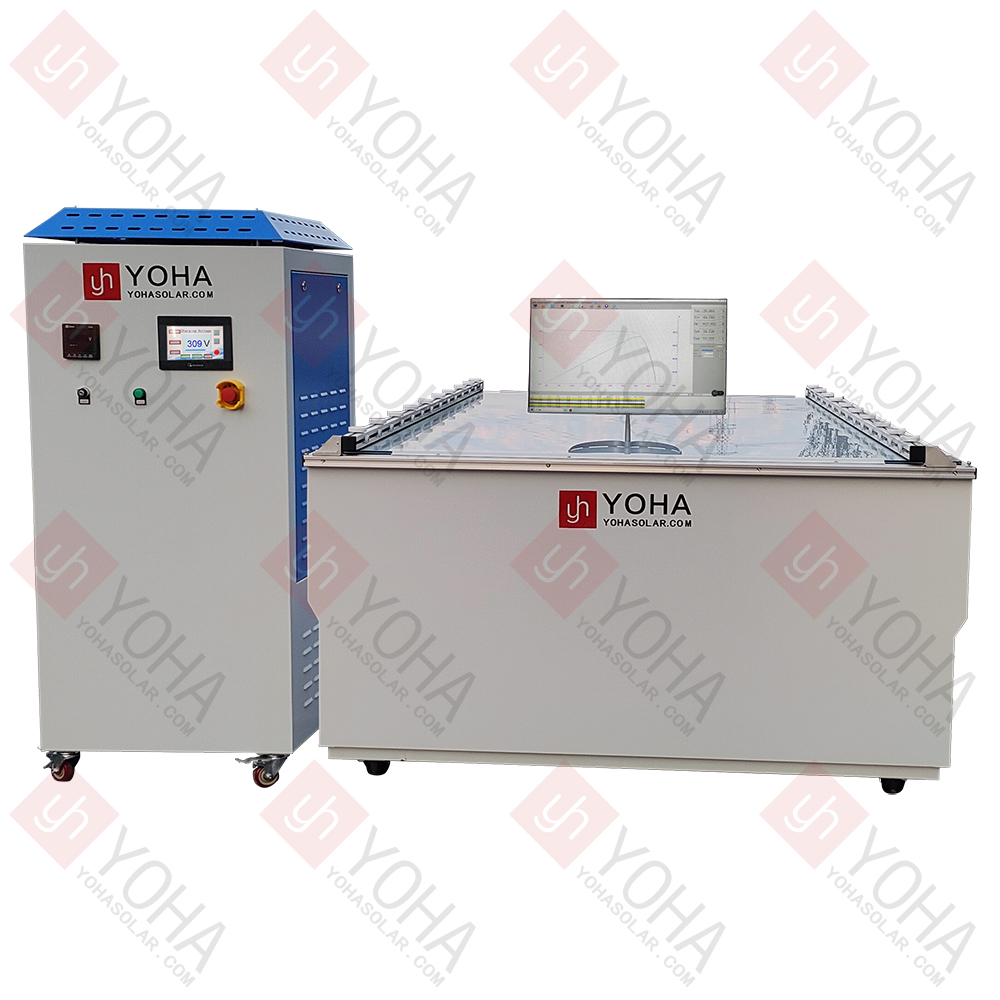Welcome to Wuhan Yoha Solar Technology Co., Ltd!
common problem
Site Map
Language:
 Chinese
Chinese
 English
English
Welcome to Wuhan Yoha Solar Technology Co., Ltd!
common problem
Site Map
Language:
 Chinese
Chinese
 English
English
The Long Pulse IV Tester for PV Modules utilizes millisecond to second-level long-pulse light sources to simulate continuous solar irradiation. It overcomes the capacitive and thermal effect errors inherent in traditional flash testers caused by excessively short pulses. This specialized equipment is designed for precisely measuring the complete current-voltage characteristic curve (IV curve) of photovoltaic modules (especially large-sized, bifacial, tandem, and other high-capacitance modules) under conditions close to actual power generation operation. It accurately calculates key performance parameters such as maximum power point (MPP), fill factor (FF), open-circuit voltage (Voc), and short-circuit current (Isc).

Long Pulse Light Source Simulates Real Conditions: Employs a 100ms long-pulse light source to effectively simulate continuous solar irradiation. Overcomes errors caused by capacitive and thermal effects in traditional flash testers due to short pulses, creating a test environment closer to the actual outdoor power generation state of modules.
High-Precision Measurement of Key Parameters: Precisely measures the complete current-voltage characteristic curve (IV curve) of PV modules under near-real conditions. Accurately calculates core performance parameters including open-circuit voltage (Voc), short-circuit current (Isc), maximum power point (Pmax / MPP), fill factor (FF), and conversion efficiency, significantly enhancing data reliability.
Wide Applicability for Various New Module Types: Particularly suitable for testing large-sized, high-capacitance modules (such as double-glass, bifacial, tandem/perovskite, HJT, TOPCon, and other new high-efficiency modules), as well as modules with significant thermal capacitance effects. Solves the problems of inaccurate or ineffective measurement with traditional flash methods on these modules.
Integrated Temperature Monitoring & High-Efficiency Automation: Equipped with high-precision temperature sensors for real-time monitoring of module temperature. Temperature is used as a key variable for data calibration (typically to Standard Test Conditions - STC), ensuring result comparability. The device typically integrates automated robotic handlers and software control systems to achieve efficient, stable assembly line testing, enhancing production inspection efficiency.
| Item | Parameter |
|---|---|
| Model Specification | YHMT-A+A+A+ |
| Light Source | Complies with IEC 60904-9:2020 Spectral Requirements (Class A+) |
| Spectral Range | 300~1200nm |
| Irradiance | 1000W/m² (200~1200W/m²) |
| Light Intensity Non-Uniformity | ≤1% (A+) |
| Light Intensity Instability | ≤0.5% (A+) |
| Test Result Consistency | ≤0.5% |
| Electrical Performance Measurement Error | ≤1% |
| Single Flash Pulse Width | 10~100ms |
| Effective Test Area | 2600*1500mm |
| Power Supply | 220V/50Hz |
| Equipment Dimensions | 2900×1770×1065mm |
1、 Strictly Adhere to Light Source Safety Protocols: The strong light pulses emitted by the equipment are high-energy and extremely bright. Never look directly at the light source or open the test chamber door during testing.
2、 Ensure Proper Grounding and Electrical Isolation: The equipment involves high voltage and high current output. It must be reliably grounded, and the power supply must meet specifications. Regularly inspect cable insulation.
3、 Precisely Control Test Environment Temperature and Humidity: Module performance is significantly affected by temperature. Pre-heat/pre-cool modules adequately to the set temperature (typically 25°C ±1°C) before testing, and precisely monitor module surface temperature in real-time (using calibrated contact sensors). Control ambient humidity within the specified range (typically <60% RH) to prevent condensation or high-voltage discharge risks.
4、 Use Test Fixtures Correctly: Regularly clean test fixtures to prevent oxidation, avoiding measurement errors or localized overheating damage to modules caused by poor contact.
5、 Regularly Calibrate and Maintain Core Equipment Components: Light source intensity (irradiance uniformity, stability), current/voltage sensor accuracy, and temperature probes are core metrology units. They must be calibrated periodically according to standards (e.g., IEC 60904 series). Also maintain optical components (clean lenses/reflectors) and mechanical movement mechanisms to ensure stable and reliable equipment status.
6、 Follow Standard Operating Procedures and Parameter Settings: Accurately input module parameters (e.g., nominal power, type) before testing. Carefully set pulse width and intensity to avoid irreversible thermal damage to modules from excessively long/strong pulses (especially for thin or temperature-sensitive materials). Allow modules to cool sufficiently after testing before proceeding to the next test or removal. When encountering abnormal data, investigate environmental factors, contact issues, and equipment status; never arbitrarily alter or ignore abnormal results.
TOP
18086473422
MESSAGE
